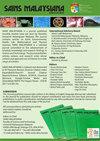制备和优化用于有效吸附镍的聚苯胺/二氧化钛/羧甲基纤维素粉末
IF 0.7
4区 综合性期刊
Q3 MULTIDISCIPLINARY SCIENCES
引用次数: 0
摘要
掺杂己酸的聚苯胺(PAni)是替代传统吸附剂去除电镀工业重金属废物(尤其是镍)的一种极具潜力的候选材料。本研究添加了不同重量百分比(wt %)的二氧化钛(TiO2)和羧甲基纤维素(CMC),以形成具有更高镍去除效率的 PAni 复合材料。通过傅立叶变换红外光谱(FTIR)、紫外可见光谱(UV-Vis)、电导率测量、X射线衍射(XRD)、热重分析(TGA)和外表面可见光谱(FESEM)对所有合成样品进行了检测,分别确认了它们的化学结构、氧化态、电导率、结晶度和金属氧化物含量、热稳定性和表面形貌。在不同的样品中,PAni / TiO2 20 % 的镍去除率最高,达到 37.5 %。在进一步添加 CMC 后,PAni / TiO2 / CMC 5 % 的镍去除率最高,达到 89.08 %。通过优化实验参数,在 pH 值为 10、接触时间为 30 分钟、温度为 30 °C、吸附剂用量为 0.01 克的条件下,镍的最高去除率达到了 97.88%。本文章由计算机程序翻译,如有差异,请以英文原文为准。
Preparation and Optimization of Polyaniline/ Titanium Dioxide/ Carboxymethyl Cellulose Powder for Effective Nickel Adsorption
Hexanoic acid-doped polyaniline (PAni) is a great potential candidate to replace conventional adsorbent towards the removal of heavy metal waste from electroplating industry, especially nickel (Ni). In this study, different weight % (wt %) of titanium dioxide (TiO2) and carboxymethyl cellulose (CMC) are added to form PAni composites with enhanced Ni removal efficiency. All the synthesized samples were examined with FTIR, UV-Vis, conductivity measurement, XRD, TGA, and FESEM to confirm their chemical structures, oxidation states, electrical conductivity, crystallinity and incorporation of metal oxide, thermal stability, and surface morphology, respectively. Among the different samples, PAni / TiO2 20 % exhibited the highest Ni removal efficiency of 37.5 %. Upon further addition of CMC, PAni / TiO2 / CMC 5 % showed the highest Ni removal efficiency of 89.08 %. Optimization of the experimental parameters were conducted and a maximum Ni removal efficiency of 97.88 % was achieved at pH 10, 30 min contact time at a temperature of 30 °C, and with an adsorbent dosage of 0.01 g. This study shows that the composite of PAni / TiO2 / CMC 5 % shows good potential to be applied as adsorbent of the removal of Ni ions.
求助全文
通过发布文献求助,成功后即可免费获取论文全文。
去求助
来源期刊

Sains Malaysiana
MULTIDISCIPLINARY SCIENCES-
CiteScore
1.60
自引率
12.50%
发文量
196
审稿时长
3-6 weeks
期刊介绍:
Sains Malaysiana is a refereed journal committed to the advancement of scholarly knowledge and research findings of the several branches of science and technology. It contains articles on Earth Sciences, Health Sciences, Life Sciences, Mathematical Sciences and Physical Sciences. The journal publishes articles, reviews, and research notes whose content and approach are of interest to a wide range of scholars. Sains Malaysiana is published by the UKM Press an its autonomous Editorial Board are drawn from the Faculty of Science and Technology, Universiti Kebangsaan Malaysia. In addition, distinguished scholars from local and foreign universities are appointed to serve as advisory board members and referees.
 求助内容:
求助内容: 应助结果提醒方式:
应助结果提醒方式:


